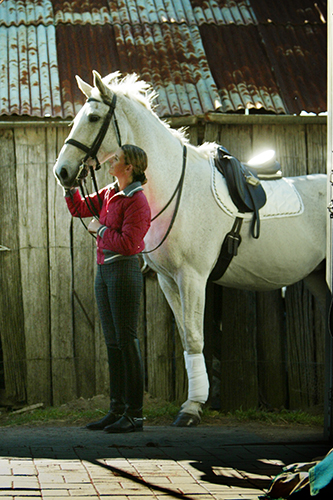 Siegfried ‘Bimbo’ Peilicke is a legend in Germany – he is a trainer’s trainer, a man with a legendary eye and the expertise that comes from having produced scores of FEI dressage horses.
Siegfried ‘Bimbo’ Peilicke is a legend in Germany – he is a trainer’s trainer, a man with a legendary eye and the expertise that comes from having produced scores of FEI dressage horses.
In Australia, we are lucky that the then twenty-one year Glennis Scott struck up such a warm friendship with Bimbo in the year she spent training with him, that now, almost twenty years later, Bimbo is still prepared to make the long trip from Germany to Australia to work with Glennis – now Barrey – her pupils and friends.
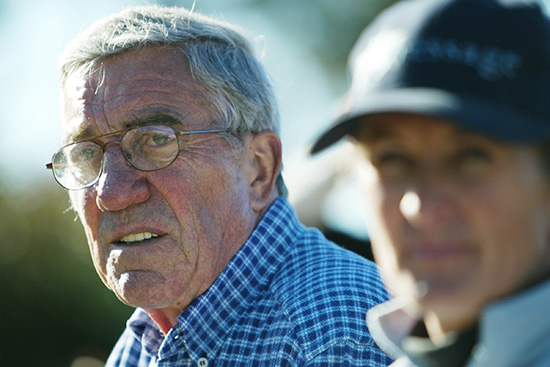
We thought it would be a great idea to send one of our exciting young riders, Shannon Tonkin off with a brief to report on her lessons with Bimbo. Shannon has not long returned from 12 months in Germany where she worked at the PSI dressage barn.
Peter Stoop was on hand to take the super photos…
As I drive into Glennis and Simon Barrey’s property, nestled in the picturesque setting of The Oaks, I am eager to experience the refinement of German training once again. I am lucky enough to have found that same dedicated training of the correct basics in Australia with my current coaches, as I found in Germany, however it will be fantastic to have the German discipline reinforced.
I am riding Liebling, a 16 year old, 17.2, Warmblood mare competing Intermediaire 1. Liebling aka Birdy, is owned by Vicky Brydon, and her daughter Amy. Vicky trained Birdy up through the levels, to the where she is at now, and it is a testament to her knowledge and skill, that Birdy is one of the most correct horses I have ever ridden.
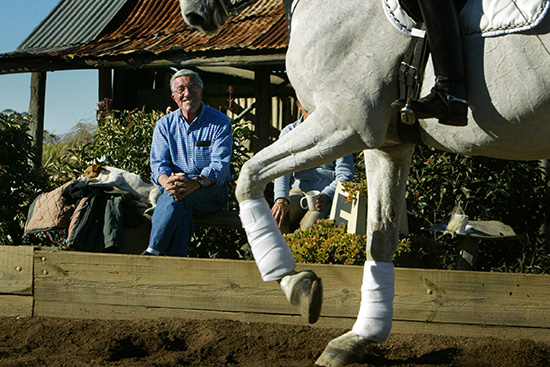
Right from the start, it was love at first sight for Birdy and myself. I had to bring her fitness and suppleness level back up and we had to learn how to work as a team to get the best out of each other.
Our goal for this clinic is to assess our progress according to correct basics. Here we go… I am the first after the lunch break, so I have ample time to warm Birdy up. Glennis is working a young Calypso Classic gelding in the arena while I am warming up. Birdy’s calm, concentrated exterior is contrasting the slightly hairy ride Glennis is having. But under Glennis’ attentive and nurturing hand, the gelding is quickly relaxing into some sensational work.
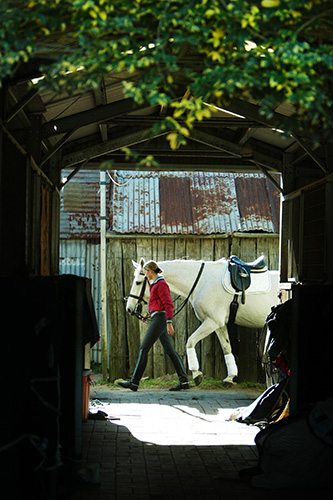
I notice Bimbo wandering down from lunch, and assume my position as the eager student. Glennis is quickly off her horse, and the lesson can begin. ‘Off you go, do some work. First some trot lateral work.’
I put Birdy into trot, and into shoulder-in down the long side, followed by a circle and travers. She feels quite good, and the bend and flexion receive the ok from Herr Peilicke via Glennis. I continue with shoulder-in and travers on the other rein, and half passes either way.
Herr Peilicke is chatting away to Glennis, and through this she instructs me to lighten my contact, lower my hands, particularly in the half pass, and allow the mare to hold herself. I concentrate on half halting through my back and shoulders, being careful to relax my seat, legs and lower back into the horse, and thus the lightening of the hands and arms becomes easier. The connection between my entire body and the horse improves, from the push through seat and legs, to the half halt through the back and seat. I must be doing something right, because I feel the next half pass becomes more fluid and balanced. And I have confirmation from Glennis -‘Good half pass’. Ooh, 80% here I come…
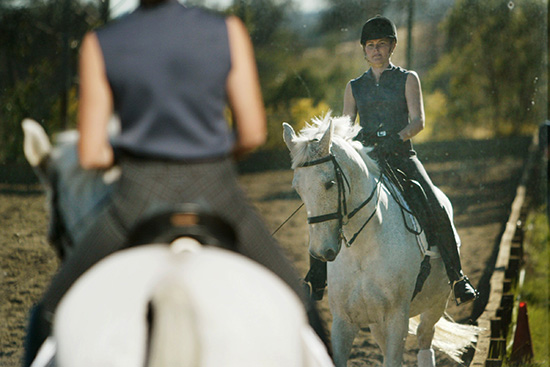
Glennis is merely an extension of Bimbo. He astutely watches, comments, and Glennis translates, often putting that slightly more ‘rider friendly’ spin on it, tailoring it to the rider’s specific needs, and bringing her own insights into play. Together, they make a formidable pair, and again it is like having two pairs of eyes roaming, so what one may miss, the other most always notes. (That is, until Maurice Bruce’s mount Neversfelde Feuer rolls in his stable, with his saddle on, distracting everybody).
For a large horse, Birdy has a lot of suppleness and elasticity in her movement, coupled with balance and rhythm, and when we can get it all together, (!) it is a feeling like no other. The trot lateral work really starts to power under Glennis and Bimbo’s tuition. There is a far better feeling of ‘up and under’; that is, up to the bridle, and under, or engaged from the hindquarters. I start to feel that she is slightly flat, and ‘ordinary’, and straight away Glennis comes with instructions to ‘give through the hand, and lift with the seat and legs.’
The easiest way to implement this is to use a little sports psychology, and visualisation and imagine the horse physically growing under you in response to your lifting through the seat and legs. You have to think of growing tall from your seat through to the top of your helmet and beyond. Ahh, thank you, and the feeling improves.
Glennis instructs me to ride the trot work more with the half halts. ‘ride her a little bit collected, then a little bit forward again, and when you collect her, loosen the poll, then give again.’ Now as you may well know, this is the basis of our riding, and the essence of asking for self-carriage. All (good) instructors say this, probably in many different ways, but for some reason, when Glennis explains it her way, you can at least get your head around the concept, and attempt to make it work. ‘Half halt, loosen, lighten, and when you lighten you push her up into the bridle to bring her back out in front of the vertical, and if she runs away, then come again already with the next half halt.’ Simple. Some of the time!
We break up the lateral work with some extensions. When you ride the extensions, you have to remember to power the outside hind through the corner and into the extension, because it has longer to travel than the inside hind, but also keeping the half halts going so the horse doesn’t run through the hand, rather he or she suspends. With this in mind, I think that I have been restricting Birdy through the neck too much in the extensions, trying for suspension.
Glennis and Bimbo pick up on my mistake immediately, telling me when I ride the extension, I must allow her to have more stretch in the neck, so she is in front of the vertical, with the nose, and make the rein lighter. I try this across the next diagonal, and as Glennis shouts, soften, soften, soften in the beat of my extension, I do lighten and soften my hands and allow her nose forward. I feel that I am loosing the suspension and degree of balance in the extension, but Glennis explains that I must push her so she extends, but not so she runs away. The next extension is super, I truly feel like I am floating. Mission accomplished.
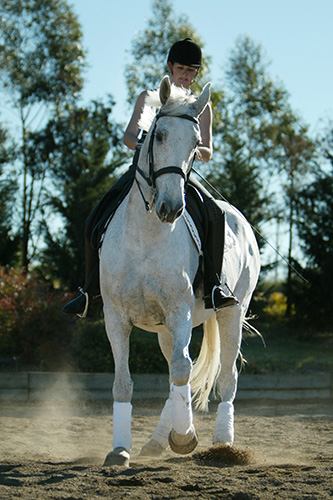
Because Birdy is such a big horse, and her stride is quite long, I must remember to work on balancing her all the time, through the careful combination of half halts and just enough push, to engage and power her without letting her run away… Ja, das ist kein problem… Now a walk break and a good active walk accompanies a nice, big stretch before we start the canter work.
As I collect the walk to prepare for the canter, Birdy starts to lift her head, hollowing through the back. Oh no you don’t…. Loosen the neck, half halt and give… Ahh, that’s better, now we can execute a decent walk to canter. The canter lacks a little impulsion, so I send her forward into a working canter, then back into a collected canter. She seems to run in the working canter, and Glennis and Bimbo both warn me against losing the collection. I employ a few more half halts, with the aim to balance the impulsion, aiming for up and through into the canter, whilst being careful not to allow her to run through my hands.
From this improved canter, I start with half pass. We have a tendency to loose the rhythm and bend in the half pass sometimes, as Birdy tries to move sideways too quickly, and lays against my inside leg. Glennis instructs me to lift her more with the inside leg, pushing it on and off, and hence allowing her to step across into the half pass with better cadence. I also must remember to balance her onto her hindquarters so she can step correctly underneath herself, through using endless amounts of half halts, keeping her soft and supple and alive to my aids.
The changes come next, with a few warm up lines of fours. She takes a few lines of changes to warm up and focus on the changes (occasionally she pretends she’s forgotten how to change at all!). Bimbo and Glennis instruct me to make her more responsive to the leg (spur, spur, spur) and sit her back on her quarters using half halts through the corner and onto the straight before the changes. Half halt, push to collect, half halt and change. A nice set of fours, and we can work on threes and twos. The same principles of collection, half halt and push are applied, just with quicker repetition.
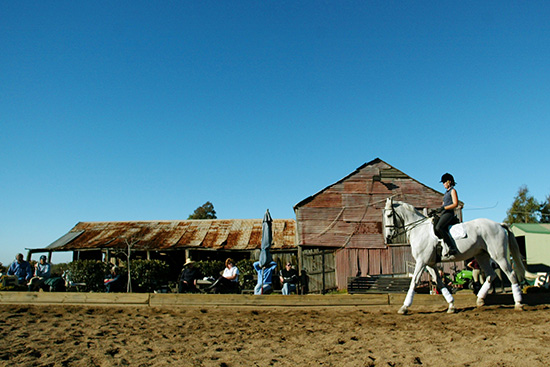
Quick thinking and action is the key to getting the sequence changes. Riders who have ridden many sequence changes find this action second nature. Others have trouble with the changes because it is quite a complicated physical and mental manoeuvre to perform in the space of seconds, requiring a certain level of physical fitness and mental agility. Think of dressage as push-ups for the brain!
Birdy and I have gotten the changes down to a fine art, where we complete a correct sequence nine out of ten times. The other time is when Birdy, whoops- I, can’t count!
My aim in this clinic is to tidy the line and placement of my changes, keeping them straight and forward, which is harder to do than you may think. Birdy will occasionally change from left to right and bring her quarters to the right. I work on keeping her straight by bringing her shoulders into line and accentuating the right shoulder action in the change, so she can’t lean into my right leg and curl around it.
She remains straighter and the changes become more expressive because all her energy and power is focussed on the change itself, not curling away from them. I love it when I can outsmart her – it doesn’t happen often, but occasionally I do have the upper hand!
The pirouettes come next, and it is time to once again confront the problem that has been plaguing me in the changes. When we come into the pirouette to the right, she does not wish to take the weight on the right hind, so she comes into the pirouette in travers. Okay, so we must put her into shoulder fore in the preparation. Easier said than done. Ever tried moving 650 kg where it doesn’t want to go? Whenever I try to use more inside leg, she escapes through my outside rein (though I don’t know how) and changes onto the left lead. When I position her into the shoulder fore, we lose the quarters to the left.
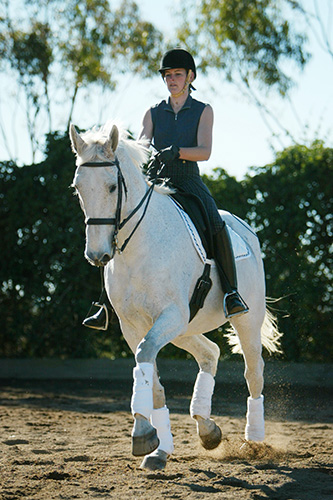
After numerous attempts I was able to get better control of the outside rein, and with a little reluctance, Birdy takes the weight on the right hind and we pull off some good pirouettes. To the left, she finds the pirouettes easier, she accepts the weight correctly on the left hind, listens to the half halts, and gives me a lovely feeling of sit, with contained power.
The lesson ends with a deep, round and stretching trot, which makes Birdy’s body feel like a slinky – all soft, supple and pliable. She enjoys this, and I can feel her mentally and physically relaxing from the hard work of the lesson. I have to contain the trot because Birdy wants to power on, (I’m sure she’s an eventer at heart). Glennis and Bimbo look pleased, and Birdy and I are tired (always the sign of a good lesson) but very satisfied with our accomplishments for the day. Jane Bruce was first cab off the rank on the second morning with the exciting young Jazz mare, Neversfelde Julia. At 8:10 am, the only people present are Jane, Bimbo and myself. Maurice is getting Feuer ready for his lesson, and Glennis is busy doing some of the million and one things she has to do everyday.
I sat and watched, and listened and occasionally spoke a broken mixture of German and English with Herr Peilicke, enough either way to communicate our ideas to each other.
Julia is much more settled this morning from the previous day (did she share some of Jane’s wine from the previous night?) showing some of the beautiful elasticity and rhythm Jane and Maurice’s horses are renowned for. Still the mare is slightly tense at times, and inclined to tighten the neck, Bimbo has Jane working on loosening and lowering her neck, working into a light, balanced frame. As soon as Julia softens through her neck, her back gives, and the quarters swing in a supple rhythm, producing an elevated, cadenced trot, and with some balancing half halts, and a few flicks of the whip, Julia demonstrates the beginnings of some magnificent collected work.
The same exercise of half halt, move the neck, soften the poll, release and push is implemented in the canter work, and Julia responds well to Jane’s instructions with a bold but balanced canter.
Maurice rides Neversfelde Feuer next, and Glennis returns to translate. I could watch Feuer work all day, and under Peilicke’s tuition, his work just gets better. Feuer is more the finished product, what we all would like our horses to be someday. The harmony between horse and rider is evident as Maurice warms Feuer up in a trot showing controlled impulsion, and a rhythm I could base my heartbeat on. My daydream in watching Maurice and Feuer is unfortunately cut short as I move to saddle Birdy for our lesson. I am told later that the highlight of Maurice’s lesson is the piaffe and passage, both become so big and engaged under Bimbo’s tuition.
Birdy and I warm up in our usual way, with many walk-halt and trot-halt transitions to engage her quarters, and wakey-wakey! It is good that Bimbo is watching my warm up today, because yesterday I had already warmed up during the lunch break before my lesson. So today he guides me from the beginning, and it proves to make such a difference.
Glennis instructs me in my trot-halt transitions stressing that when she becomes too tight and restricted through the neck, I must loosen the neck, soften and lighten the hands, half halt to balance, whilst driving her into the transition.
In the first few transitions, I feel I am giving too much, and that she is merely falling into the transition, but after a few more half halt and give instructions from Glennis, and a few more leg aids from me, I am producing good, balanced downward transitions.
A trot to halt transition appears so basic and simple, but the transitions are the basis of all our work, and aid in balancing, strengthening, and creating obedience and responsiveness in the horse. So basically, you can never practice too many, and you can never perfect them! Excellent maybe, but not perfect!
Birdy is already feeling better than yesterday, more supple and responsive, and definitely lighter. We move into the laterals in trot. (It is now I notice the two rub marks at the back of my knees from my boots from yesterday- ouch!) Birdy flows into a rhythmical shoulder-in, with cadence and balance, which gives me a good feeling for the half-pass.
The half-pass lacks energy in the beginning, and Bimbo instructs me to keep a soft hand, use more half halts to balance her so she can step across in a rhythm, and then, keep the push to maintain the rhythm into the soft hand. It sounds like a lot, but when accomplished, it creates a wonderful half-pass that flows and is balanced. Do I look like Maurice yet?!
We work on the extended trot more today, and again I must let/make her become looser and freer through the neck, poll and gullet, in order for her to engage the hindquarters and move over the back more freely, and not restrict the front leg action. Birdy LOVES extended trot, so she gives 110% all the time and tries so hard. Sometimes she tries too hard, and we lose our rhythm, so I must harness the energy and ask for a balanced 90%, making sure it is not too tight through the neck. Today, however, to my advantage, it is too tight through the neck, so I get the expertise of Bimbo and Glennis instructing me to loosen her neck through the corner, in preparation for the extension, and then half-halt and lighten my contact, allowing her to carry herself in the extension. As soon as I do this, I feel I have lost the suspension, and can feel her starting to run through my hands. I try again with more half halts through my back, whilst maintaining softness through the hands and elbows, and although I get ‘sehr gute’ from the sidelines, I still feel that by softening the contact I forego the suspension. I try again, thinking more about softening her frame through my hands, but holding the suspension through my back (instead of go-go-gadget, I try to think of go-go-Birdy on springs) and the feeling improves. Ahh, good girl Birdy… and into a walk break and a nice stretch. The canter work starts well, and only improves. We work on transitions within the pace, particularly collecting the canter to sit on the hindquarters, release the rein forward up the neck, and forward in the pace again. I start this exercise, and immediately I hear the German flowing in a tone denoting dissatisfaction.
I am told by Glennis that I am asking for too much collection, and thus loosing the balance and the tempo in the canter, and she is becoming too short in the neck and too strong in the hand. I must not hold the extreme collection for too long, but maintain the tempo into the collection, in the collection, and out of the collection. Thus, the transitions in the pace become the most important part. I am instructed by Bimbo and Glennis to half-halt, loosen the neck, give the reins, soften, and push her into the soft contact. It does not come perfectly at the beginning, with a mixture of wobbling head, too much take, too much give, not enough push, and too much push, but with some guidance and a little experimentation, the balance within the collection improves.
Now keeping the collection feels far easier, and the balance is carried forward into half pass that moves freely and smoothly beneath me. When the half pass looses impulsion, suppleness and bend, I look to Glennis and Bimbo for help, and again we return to half halts, resulting in balance and collection. As I loosen the poll, lower the neck and collect with the outside rein, she is able to step through and over with the leading fore leg, improving the flow and reach of the half pass. This feels good. I feel the rhythm in the movement improving.
We tackle the flying changes next. Birdy loves the changes; they are one of her strong points. I ride a set of three fours to warm up, and another line with five threes. She feels a little unresponsive to my right leg, so in my concentration to correct this problem, I ride a rather untidy line and placement in the changes. Bimbo is enthusiastically (I hope!) talking to Glennis, and from this, I am instructed to collect her more into the changes, during the changes, and – don’t forget it – after the changes.
The changes are allowed to be forward moving, but must remain collected throughout, and the canter after the changes must be collected in finishing the movement, and preparing for the next. Next, I have to work on the placement of the changes. For those who don’t know, when riding tempi changes, the middle change should be on the centre line. So for each rider, where you start the changes will depend on individual horses’ strides, degree of collection etc. Birdy has a big canter stride, so I must start quite early. I think that previously I have been starting too early, so I wait a few more strides this time, and with the extra collection, we execute a lovely line of centred changes and “COLLECT after the changes!!” We collect after the changes. With this feeling, the fours, threes and twos feel more balanced, more centred and straighter.
If there is anything Birdy loves more than flying changes, then it has to be the pirouettes. Vicky has trained Birdy so precisely and correctly in the pirouettes, and it is up to me to learn how to ride them on her. She naturally takes the weight on her quarters very well to the left, but resists a little to the right. I need to learn to control the turn and the bend, and maximise the potential in the collection. To the left we can get a good (remember judges – that’s an 8) pirouette, to the right we both work harder, but it is also quite good when we take the weight correctly.
We start today with a better feeling of shoulder fore to the right, and the pirouettes immediately feel better than yesterday. Half halt, loosen and lighten, and when the feeling of soft balance comes, then ask for the pirouette. Awesome! What a sensation a correct pirouette feels like. What an improvement from yesterday. The right pirouettes still lack the engagement that I feel in the left ones, but both have improved.
As the lesson draws to a close, we finish with a long and low trot stretch and a relaxing walk, and I contemplate my experience over the past two days. Over the two lessons, I have had reinforced the importance of half halts (Glennis and Bimbo’s mantra of ‘half halt, loosen lighten and push’) and their ability to improve every facet of the horse’s movement. I now chant it in my sleep! I am pleased to see that Birdy and I are on the right track in terms of our training, and that which I have trouble with can certainly be improved upon through constant work of strengthening, suppling, and training with the right guidance.
After two days of riding, watching, learning, listening, talking, questioning, thinking and contemplating, I realise how much I have learnt but how much there still is for all of us to learn. Clinics like this give you immense satisfaction, and the ambition to continually lift your game, to strive constantly for the betterment of yourself as a rider, and most importantly, highlighting the important role your horse plays in your life.
For me, Birdy is my best friend.
PS. My thanks to Pernille Hogg of Catago Riding Wear, who supplied the clothes so I could look fashionably smart for the photo shoot…
